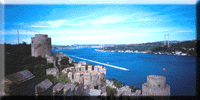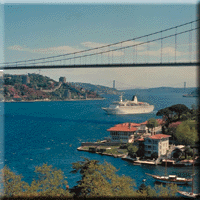Bosphoros
The Bosphorus links
the Black Sea, referred to in ancient times as Pontius Euxinus, with the
Sea of Marmara, known as Propontis. The Bosphorus was formerly known as
Bosporos and there is a legend to enrich this
name. It is considered that the root of this name, Bos,is of
Thracian origin. The length of the Bosphorus ranges between 28.5km and
31.7km (depending on where it is measured), which means an average length
of 30km. Its width at the northern end is 4700m, and at the southern
end, 2500m. The widest place in the Bosphorus is in the Büyükdere
vicinity (3300m), and the narrowest place is that which lies between
Rumelihisar and Kanlıca (660-700m). It is known that the deepest part of
the Bosphorus is 100m in depth. Apart from this, there are two main
currents in the Bosphorus; one of these is the surface current, flowing
from the Black Sea to Marmara, and this could be considered as the surplus
waters of the Black Sea. The other current flows along the bed of this
channel from Marmara towards the Black Sea under the hydrostatic pressure
of salty, heavy density water. A number of hypotheses exist about the
formation of the Bosphorus;
1. That the
Bosphorus came about as a result of a wearing away by friction; that the
surplus waters of the Black Sea, which is an inland sea, gradually wore
away the channel now known as the Bosphorus.
2. That the
Bosphorus came into being as a result of volcanic action and that the
water of the Black Sea flowed through the fissure that opened up.
3. That the
Bosphorus was originally a valley which gradually filled with water.
 A
stay in Istanbul is not complete without the traditional and unforgettable
boat excursion up the Bosphorus, the winding strait that separates Europe
and Asia. Its shores offer a delightful mixture of past and present, grand
splendor and simple beauty. Modern hotels stand next to yalı (shorefront
wooden villas), marble palaces abut rustic stone fortresses, and elegant
compounds neighbor small fishing villages. The best way to see the
Bosphorus is to board one of the passenger boats that regularly zigzag
along the shores. You embark in A
stay in Istanbul is not complete without the traditional and unforgettable
boat excursion up the Bosphorus, the winding strait that separates Europe
and Asia. Its shores offer a delightful mixture of past and present, grand
splendor and simple beauty. Modern hotels stand next to yalı (shorefront
wooden villas), marble palaces abut rustic stone fortresses, and elegant
compounds neighbor small fishing villages. The best way to see the
Bosphorus is to board one of the passenger boats that regularly zigzag
along the shores. You embark in
Eminönü
and stop alternately on the Asian and European sides of the strait. The
round-trip excursion, at a very reasonable cost, takes about six hours. If
you wish a private voyage, you can contact one of the agencies which
specialize in organizing day or night mini-cruises.
During
the journey, you pass in front of the magnificent Dolmabahçe Palace;
farther along rise the green parks and imperial pavilions of Yıldız
Palace. On the edge of this park, on the coast, stands Çırağan Palace
,now restored as a grand hotel. Refurbished in 1874 by Sultan Abdülaziz,
it stretches for 300 meters along the Bosphorus shore, its ornate marble
facades reflecting the swiftly moving water. In Ortaköy, the next stop,
artists gather every Sunday to exhibit their works in a streetside
gallery. The variety of people create a lively scene; sample a delicious
bite from one of the street vendors. In Ortaköy, there is a church,
mosque and a synagogue that have existed side by side for hundreds of
years - a tribute to Turkish secularism and tolerance. Overshadowing
Istanbul's traditional architecture is the Bosphorus Bridge, one of the
world's largest suspension bridges linking Europe and Asia.
 The
beautiful Beylerbeyi Palace lies just past the bridge on the Asian side.
Behind the palace rises Çamlıca Hill, the highest point of Istanbul. You
can drive here to admire the magnificent panorama of Istanbul as well as
the beautiful landscaped gardens. On the opposite shore, the wooden
Ottoman villas of Arnavutköy contrast with the luxurious modern
apartments of neighboring Bebek. A few kilometers farther out, facing each
other across the straits like sentries guarding the city, stand the
fortresses of Rumeli Hisarı and Anadolu Hisarı. The Göksu Palace,
sometimes known as Küçüksu Palace graces the Asian shore, next to
Anadolu Hisari. The second link between the two continents; the Fatih
Sultan Mehmet Bridge straddles the waterway just past the two fortresses. The
beautiful Beylerbeyi Palace lies just past the bridge on the Asian side.
Behind the palace rises Çamlıca Hill, the highest point of Istanbul. You
can drive here to admire the magnificent panorama of Istanbul as well as
the beautiful landscaped gardens. On the opposite shore, the wooden
Ottoman villas of Arnavutköy contrast with the luxurious modern
apartments of neighboring Bebek. A few kilometers farther out, facing each
other across the straits like sentries guarding the city, stand the
fortresses of Rumeli Hisarı and Anadolu Hisarı. The Göksu Palace,
sometimes known as Küçüksu Palace graces the Asian shore, next to
Anadolu Hisari. The second link between the two continents; the Fatih
Sultan Mehmet Bridge straddles the waterway just past the two fortresses.
From
Duatepe Hill, on the European side, you can admire the magnificent
panorama of the bridge and the Bosphorus. Below Duatepe, beautiful Emirgan
Park bursts with color when the tulips bloom in spring. Opposite, on the
Asian shore is Kanlıca, a fishing village now a favored suburb for
wealthy Istanbulites. Crowds gather in the restaurants and cafes along its
shores to sample its famous yogurt. Shortly after Kanlıca and Çubuklu is
the Beykoz Korusu (Abraham Paşa Woods), a popular retreat. In the cafes
and restaurants you can enjoy the delightful views and clear fresh air. On
the European side, at Tarabya Bay, yachts seem to dance at their moorings.
The coast road bustles with taverns and fish restaurants from Tarabya to
the charming suburbs of Sarıyer and Büyükdere. Sarıyer has one of the
largest fish markets in Istanbul and is also famous for its delicious
varieties of milk puddings and börek (pastries). A little further on past
Sarıyer, the narrow strait widens and disappears into the Black Sea.
|